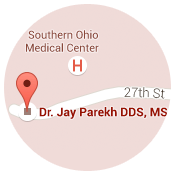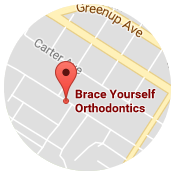BRACE YOURSELF ORTHODONTICS Accessibility Statement
BRACE YOURSELF ORTHODONTICS is committed to facilitating the accessibility and usability of its website, byortho.com, for everyone. BRACE YOURSELF ORTHODONTICS aims to comply with all applicable standards, including the World Wide Web Consortium's Web Content Accessibility Guidelines 2.0 up to Level AA (WCAG 2.0 AA). BRACE YOURSELF ORTHODONTICS is proud of the efforts that we have completed and that are in-progress to ensure that our website is accessible to everyone.
If you experience any difficulty in accessing any part of this website, please feel free to call us at (740) 354-4284 or email us at info@byortho.com and we will work with you to provide the information or service you seek through an alternate communication method that is accessible for you consistent with applicable law (for example, through telephone support).
Ortho Dictionary
Choose a glossary:
Parts of Braces
-
Appliance
-
Anything your orthodontist attaches to your teeth that moves your teeth or changes the shape of your jaw.
-
Archwire
-
The metal wire that acts as a track to guide your teeth as they move. It is changed periodically throughout treatment as your teeth move to new positions.
-
Band
-
A metal ring that is cemented to your tooth that goes completely around it. Bands provide a way to attach brackets to your teeth.
-
Bond
-
The seal created by orthodontic cement that holds your appliances in place.
-
Bracket
-
A metal or ceramic part cemented (“bonded”) to your tooth that holds your archwire in place.
-
Coil Spring
-
A spring that fits between your brackets and over your archwire to open space between your teeth.
-
Elastic (Rubber Band)
-
A small rubber band that is hooked between different points on your appliance to provide pressure to move your teeth to a new position.
-
Elastic Tie
-
The tiny rubber band that fits around your bracket to hold the archwire in place. They come in a variety of colors.
-
Headgear
-
Headgear uses an external wire apparatus known as a facebow to guide the growth of your face and jaw gently by moving your teeth into proper position. The force is applied to the facebow by a spring-loaded neck strap or head strap. The straps have a safety release that disconnects if the facebow is pulled or snagged.
-
Headgear Tube
-
A round, hollow attachment on your back bands. The inner bow of your headgear fits into it.
-
Hook
-
A welded or removable arm to which elastics are attached.
-
Ligature
-
A thin wire that holds your archwire into your bracket.
-
Lip Bumper
-
A lip bumper is an archwire attached to a molded piece of plastic. The lip bumper holds back the molars on your lower jaw to provide more space for your other teeth.
-
Mouthguard
-
A device that protects your mouth from injury when you participate in sports or rigorous activities.
-
Palatal Expander
-
A device that makes your upper jaw wider.
-
Retainer
-
An appliance that is worn after your braces are removed, the retainer attaches to your upper and/or lower teeth to hold them in place. Some retainers are removable, while others are bonded to the tongue side of several teeth.
-
Separator or Spacer
-
A small rubber ring that creates space between your teeth before the bands are attached.
-
Tie Wire
-
A fine wire that is twisted around your bracket to hold the archwire in place.
-
Wax
-
Wax is used to stop your braces from irritating your lips.
Orthodontic Procedures
-
Banding
-
The process of fitting and cementing orthodontic bands to your teeth.
-
Bonding
-
The process of attaching brackets to your teeth using special orthodontic cement.
-
Cephalometric X-ray
-
An X-ray of your head that shows the relative positions and growth of the face, jaws, and teeth.
-
Consultation
-
A meeting with your orthodontist to discuss a treatment plan.
-
Debanding
-
The process of removing cemented orthodontic bands from your teeth.
-
Debonding
-
The process of removing cemented orthodontic brackets from your teeth.
-
Impressions
-
A model of your mouth made by biting into a soft material that hardens into a mold of your teeth. Your orthodontist will use these impressions to prepare your treatment plan.
-
Invisalign®
-
An alternative to traditional braces, Invisalign straightens your teeth with a series of clear, custom-molded aligners. Invisalign can correct some, but not all, orthodontic problems.
-
Ligation
-
The process of attaching an archwire to the brackets on your teeth.
-
Panoramic X-ray
-
An X-ray that rotates around your head to take pictures of your teeth, jaw, and other facial areas.



